ALP 1.3%
Incumbent MP
Lisa Chesters, since 2013.
Geography
Bendigo and surrounding parts of northwestern Victoria. Bendigo covers Greater Bendigo and Mount Alexander council areas, as well as parts of Loddon, Mitchell and Macedon Ranges. A majority of the population lives in Bendigo, and the other major town is Castlemaine.
History
Bendigo is an original federation electorate. In its 110-year history, the seat has switched back and forth between the major parties.
Bendigo was first won in 1901 by Protectionist candidate John Quick. Quick was a Victorian colonial MP and a delegate to the Constitutional Conventions. Quick served as a member of Alfred Deakin’s third ministry in 1909, and held the seat until his defeat in 1913.
Bendigo was won in 1913 by prominent lawyer John Arthur, standing for the ALP. Arthur won re-election in 1914 and was appointed Minister for External Affairs in the third Fisher government, but quickly fell ill and died in December 1914, aged 39.
The 1915 Bendigo by-election was won by the ALP’s Alfred Hampson. Hampson remained loyal to the ALP when it split over the issue of conscription in 1916, but at the 1917 election he was challenged for his seat by Prime Minister Billy Hughes, who had switched from the ALP to the new Nationalist Party.
Hughes had been a member of the House of Representatives since federation, holding the seat of West Sydney. He had served as a minister in the Labor governments of Chris Watson and Andrew Fisher, before becoming Prime Minister in 1915 upon Fisher’s retirement.
Hughes held Bendigo until 1922, when he switched to the seat of North Sydney. At that election his party lost its majority, and the price of Country Party support for the Nationalist government was Hughes’ replacement as Prime Minister by Stanley Bruce.
Hughes remained in Parliament for another three decades. He served on the backbench through Stanley Bruce’s government, before leading a group of rebels in 1929 which saw Bruce lose his majority and then lose the following election. Hughes later served in ministerial roles and indeed as leader of the United Australia Party, and served as an MP until his death in 1952.
Bendigo was won in 1922 by Nationalist candidate Geoffrey Hurry, who defeated the Country Party’s Edmund Jowett, whose seat of Grampians had been abolished in the redistribution. Hurry held the seat until the 1929 election, when he lost his seat.
Bendigo was won in 1929 by Richard Keane, who was General Secretary of the Australian Railways Union. He only held Bendigo for one term, losing in 1931, but later was elected to the Senate in 1937. He served as a minister in the wartime Labor governments, and died in 1946 while on government business in Washington DC.
Eric Harrison of the United Australia Party won Bendigo in 1931. He was re-elected in 1934, and attempted to move to the new seat of Deakin in 1937, but failed to win preselection, and retired.
In 1937, Bendigo was won by the Country Party’s George Rankin. Rankin held the seat until 1949, when the redistribution changed Bendigo substantially, and he was successful in winning election to the Senate. He served in the Senate until he retired in 1955.
In 1949, the ALP’s Percy Clarey won Bendigo. Clarey had been a member of the Victorian upper house and a state minister, while also serving as President of the ACTU. Clarey held the seat until his death in 1960.
The 1960 by-election was won by the ALP’s Noel Beaton. He held the seat until he resigned in 1969, triggering another by-election. The second by-election was won by the ALP’s David Kennedy. Kennedy lost Bendigo in 1972, against the flow of an election where Gough Whitlam won power for the ALP.
The Liberal Party’s John Bourchier won Bendigo in 1972, and held it until 1983, when he lost to the ALP’s John Brumby.
Brumby was re-elected in 1984 and 1987, but lost in 1990. Brumby was elected to the Victorian Legislative Council at a by-election in 1993, and only four months later was elected Leader of the Victorian ALP and won a second by-election for a Legislative Assembly seat. Brumby served as Opposition Leader until early 1999, when he stepped aside for Steve Bracks. Brumby served as a senior minister in the Bracks government from 1999 until Bracks’ retirement in 2007, when Brumby was elected as Premier. Brumby served as premier for three years before losing the 2010 election, and retiring from Parliament.
Bruce Reid won Bendigo for the Liberal Party in 1990. He held the seat until 1998, when the ALP’s Steve Gibbons won the seat. Gibbons was elected in Bendigo six times, and retired in 2013.
Labor candidate Lisa Chesters won Bendigo in 2013.
Candidates
- Andy Maddison (Nationals)
- Rosemary Glaisher (Greens)
- Sandy Caddy (Rise Up Australia)
- Lisa Chesters (Labor)
- Megan Purcell (Liberal)
- Ruth Parramore (Animal Justice)
- Anita Donlon (Independent)
- Alan Howard (Family First)
Assessment
Bendigo is a key marginal, but Labor should benefit from the sophomore surge as Lisa Chesters develops a personal vote to replace that lost in 2013.
2013 result
| Candidate | Party | Votes | % | Swing |
| Greg Bickley | Liberal | 36,701 | 39.7 | +3.8 |
| Lisa Chesters | Labor | 33,829 | 36.6 | -10.4 |
| Lachlan Slade | Greens | 8,600 | 9.3 | -3.7 |
| Sarah Sheedy | Nationals | 4,644 | 5.0 | +5.0 |
| Anita Erika Donlon | Palmer United Party | 2,336 | 2.5 | +2.5 |
| Charlie Crutchfield | Sex Party | 2,220 | 2.4 | +2.4 |
| Alan Howard | Family First | 1,036 | 1.1 | -3.0 |
| Stephen John Stingel | Katter’s Australian Party | 745 | 0.8 | +0.8 |
| Ewan Mcdonald | Australian Christians | 567 | 0.6 | +0.6 |
| Daniel Edward Abikhair | Independent | 545 | 0.6 | +0.6 |
| Rod Leunig | Country Alliance | 538 | 0.6 | +0.6 |
| Sandra Caddy | Rise Up Australia | 499 | 0.5 | +0.5 |
| Matine Rahmani | Independent | 259 | 0.3 | +0.3 |
| Informal | 5,600 | 6.1 |
2013 two-party-preferred result
| Candidate | Party | Votes | % | Swing |
| Lisa Chesters | Labor | 47,426 | 51.3 | -8.2 |
| Greg Bickley | Liberal | 45,093 | 48.7 | +8.2 |
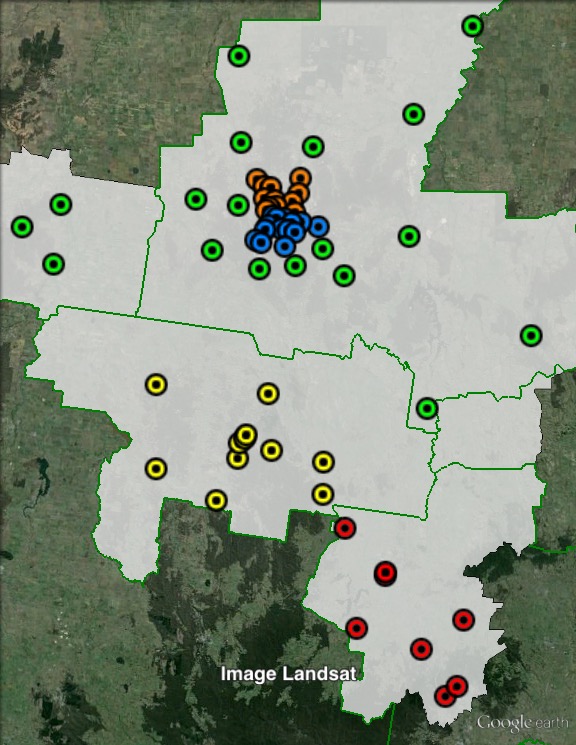
Booth breakdown
Booths have been divided into five areas. Polling places in the Mount Alexander and Macedon Ranges shires have been split up into two groups.
Polling places in the Greater Bendigo council area have been split into three groups. Those polling places in the Bendigo urban area have been split into “south” and “north”, with the remainder grouped as “Bendigo Rural”.
The ALP won a majority of the two-party-preferred vote in four areas, ranging from 52.2% in Bendigo South to 63% in Mount Alexander. The Liberal Party only won a majority in rural parts of Bendigo council area, with 56.4%.
The Greens came third, with a vote under 10% in the Bendigo area, but over 15% in the Macedon Ranges and over 20% in Mount Alexander.
| Voter group | GRN % | ALP 2PP % | Total votes | % of votes |
| Bendigo South | 8.1 | 52.2 | 9,857 | 20.8 |
| Bendigo Rural | 5.8 | 43.6 | 5,533 | 11.7 |
| Bendigo North | 5.6 | 56.7 | 6,760 | 14.3 |
| Mount Alexander | 20.4 | 63.0 | 5,669 | 12.0 |
| Macedon Ranges | 15.1 | 53.0 | 4,686 | 9.9 |
| Other votes | 8.0 | 47.8 | 14,921 | 31.5 |
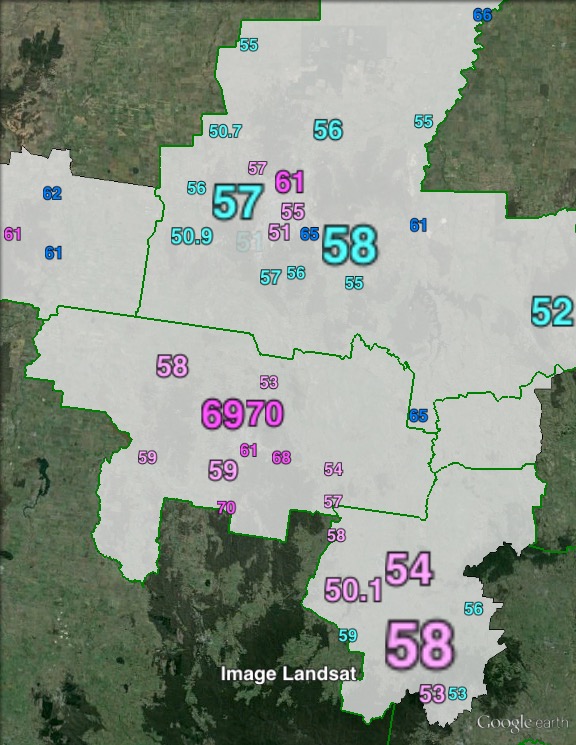
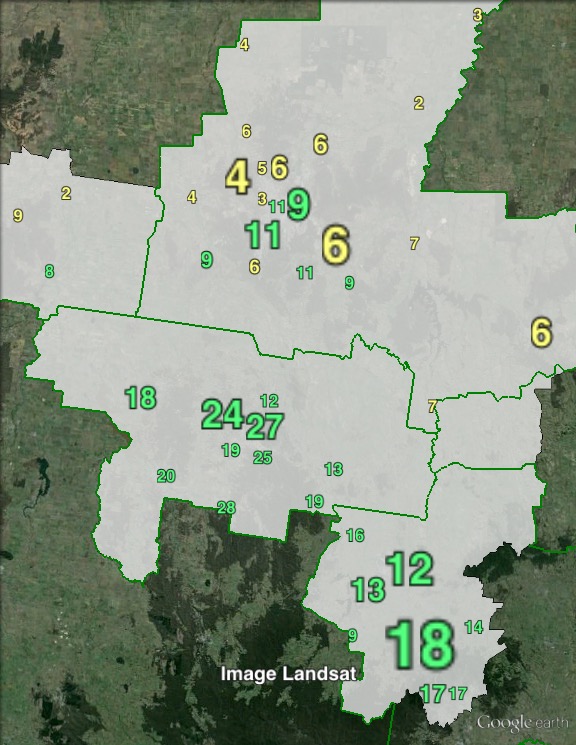
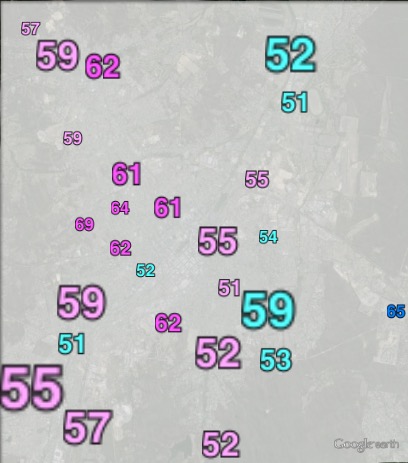
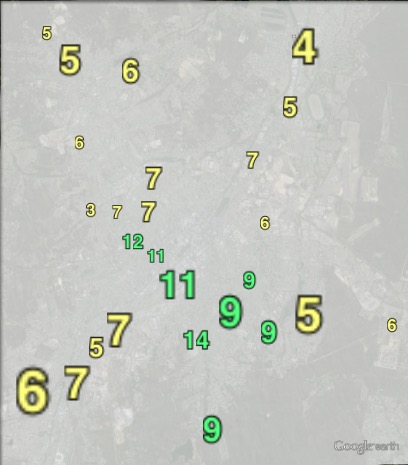


Of all the rural seats in contention, this would have been the likeliest to go for the Coalition in the midst of the Turnbull honeymoon. Now that the contest has closed considerably however, coupled with the expected sophomore surge, I think the ALP will be home and dry here. Not to mention that it seems the area has become friendlier to Labor since the 90s, after all this was where Jeff Kennet unexpectedly lost his majority in ’99 and these (state) seats have yet to return to the Coalition.
W of S
The Vic govt has moved a lot of govt departments to Bendigo, & Ballarat. They are now far less marginal as a result.
@Winediamond, if that is correct, then it almost certainly explains the area becoming more Labor-friendly – the public service obviously overwhelmingly dash to vote left with little exception.
Hi Ben,
You seem to have got Macedon Ranges and Mount Alexander the wrong way around. Macedon Ranges is in the far south, Mount Alexander is the closer to Bendigo.
I thought your assertion that Labor got 60%+ in Macedon Ranges sounded weird!
MM
What do you think are the chances of Bendigo losing I’ts southern flank, & becomng more marginal ??
Of my understanding the Nats will be contesting here, as well as in Ballarat and McEwen. That could make it interesting. Out of all those seats i’d expect this to be their best seat.
WD: Certainly if Murray or Indi is abolished, and a new seat created in north-west Melbourne, Bendigo would lose some of its southern areas and move north into more conservative territory.
Macedon Ranges itself is not THAT Labor, so Bendigo would need to lose Mount Alexander Shire (or at least Castlemaine) to change the margin by any great amount.
MM
Yes i was thinking that exactly, but what are the chances ??. The case for abolishing Murray in some form must surely be irresistible by now ??
WD: Given the AEC tried to do that last time, I’d say chances are high it would be tried again. I agree that it’s not practical to push Murray or Indi any further south, or push Bendigo and Ballarat any closer to Melbourne.
It would certainly be something I would advocate for at the next redistribution.
MM
I always enjoy your advocacy immensely !!.
As an aside, my family comes from the Bendigo area, so I know a bit about some of this region.
West Bendigo: lower class, housing Commission, not-very-desirable part of Bendigo. Reliably 60-70% Labor, although may be slightly weakening as the old public housing residents are slowly gentrified.
East Bendigo: more affluent/middle class and generally “nicer” suburbs e.g. Strathdale. You can see the 50-50 type booths around here, although I think the Liberals would be hoping to do a bit better.
Mount Alexander: Tree-changer, New Age types who have turned some of the old railway and mining towns into Trendy-villes. Hence the very high Green vote and strong Labor 2PP in this area.
Macedon Ranges: A bit of the “trendy” crowd here too, but towns such as Kyneton and especially Woodend are increasingly becoming part of Melbourne’s commuter belt. The area is probably drifting away from the Liberals, but you can see that it is still only 50-60% Labor.
Rural Bendigo: more traditional rural area in the mould of Mallee and Murray, plus semi-rural exurbs like Strathfieldsaye and Huntly. Hence the much stronger Liberal vote.
Thanks Mark, error fixed.
@MM great local analysis!
MM
Well done. As always.
It is interesting how a small country city can manage to have such a significant socio-economic divide. Seemingly for little reason
2013 was not the best election for Labor to have retiring long term members in marginal(-ish) seats. (c.f. Capricornia, Barton.) They got away with it in Bendigo.
I know nothing about Lisa Chesters. But if she’s even a half-decent local member, she should have consolidated Labor’s position here.
I think the Liberal candidate would’ve won here (albeit by the slimmest of margins) in 2013 had the Nationals not run. Clearly the high number of candidates contesting Bendigo last time split the conservative side of politics vote many different ways. I think with Megan Purcell’s recent public profile as a contestant on Farmer Wants a Wife, she may get some name ID. However, I still have Labor winning this time with a swing in their favour. Mostly because the Nationals are running here again.
PRP
I presume you are talking WRT leaking of preference???, However the informal vote does not seem excessive
There’s probably a non-negligible number of voters who put a 1 for their favored party, then straight down the ticket after that.
kme
That is a thought
PRP
The vast majority of these Nat voters would have preferenced Liberal before Labor so I doubt this would have affected the overall outcome in TPP in 2013.
The lack of a personal vote from Gibbons would have played a crucial role in Liberals getting within ‘shouting’ distance of a win in Bendigo. However, Chester will have built a small personal vote coupled with an increase in public servants moving to the electorate of late, I would predict a Labor retain with an increase in the TPP.
Not likely while Melbourne dominates the state’s population growth. More likely that a little bit more of the north will be nibbled off to beef up the enrollment in Mallee or Murray. I doubt that the commissioners will make another try to abolish a country seat: there’s no need to.
I’ll nail my colors to the mast here.
I expect the newt seat to be based on the city of Brimbank (which releases pressure from Lalor, McEwen, and Gorton), the SE will be short 0.8 of a quota, but AEC will base it projection on projected 2022 enrollment and by that stage SE will be short one whole quota. The question is will they abolish a seat in the SE or move Casey and Menzies into Banyule and Nullumbik. This scenario pushes McEwen back into Macedon Ranges and Bendigo into Central Goldfields.
I’m 75% sure it will be a seat being abolished in the SE so to confine the big boundary changes to the urban area. Then Loddon will move into Mallee, Some of Bendigo Shire (Elmore and Heathcote specifically) will move into Murray and Bendigo will move into Macedon Shire as Mcwen moves back into the Yarra Valley.
MM- I always thought the AEC started the redistribution with the seats of Murray, Gippsland and Wannon moved towards the city then and finished with Isaacs and Hotham.
If they don’t abolish a rural seat, then regional Victoria is going to get messy. You are going to have parts of Bendigo and maybe Ballarat split off from the seats of that name. Murray or Indi will probably need to push down almost to the outer fringe of Melbourne, and possibly Corio will be forced to jump Little River (which as I said, is not something the AEC likes to do).
There is a huge deficit in the south-eastern suburbs, though. It might even be that two new seats are created and two seats abolished, with Melbourne pushed across the Yarra into Southbank. It will be interesting to see what the projections say in a year or so’s time.
The Liberal candidate was extremely strong last time and significantly out-spent Labor on the ground, in the minds, and the all-important WIN news and the “Addy”. Mark Bickley was well known locally and already had a high profile due to his involvement in local footy.
As a resident of the northern suburb of Epsom, we haven’t seen any material in our letterbox yet for either candidate. The Liberal party is playing dead, albeit preselecting someone who might have been on some show once that no-one saw.
A swing is about what’s different in one election compared to the next. The absence of Bickley will cost the Liberal Party at least 5% this time. Combined with a more general anti-Liberal swing, this seat will return to its recent historical “safe Labor” levels.
Demographically, the population growth areas are:
– Maiden Gully / Marong (West) – strong Liberal
– Strathfieldsaye / Junorton (East) – strong Liberal
– Huntly (North) – marginal Labor
In addition, there is significant growth in inner Bendigo (new units) that will likely favour Liberal and Green percentages at the expense of Labor (and even the Nats).
Government departments have not been transferred to Bendigo. In fact, our marginal status has been used to get us a new hospital (~$500m cost for 100k people), swimming pool, arts funding, and myriad other funding from state and federal governments.
Bendigo’s growth is at a higher rate (~2.2% per annum) than the state average and will tend to shrink the seat and perhaps some regional areas (far east and far west) will be lopped off, further entrenching Labor’s position by magnifying the fact that Bendigo is still more working class and more Labor than Melbourne (for example).
My prediction: Likely Labor hold.
Only a Liberal voter could call Bickley a strong candidate, he only got close because of the loss of the very substantial personal vote Steve Gibbons had built up over several terms. With the anti-Labour rage in the electorate in 2013 any quality Liberal candidate should have won, particularly with their much larger add spend. Bickley also lost the subsequent State election against Jacinta Allan, although then the swing was on in Labor’s favour. The seat was also made harder for Labor in 2013 by the loss of the area around Maryborough. Whilst the surrounds are conservative, Maryborough itself is an area of particular social disadvantage and a Labor stronghold. In short any half decent Liberal candidate should have taken the seat.
There is a ground swell of opinion in some parts of the electorate (particulalry among the left leaning intelligentsia) that Purcell’s Reality TV credentials tarnish her somewhat, in others it’s a case of any publicity is good publicity.
Chesters has been highly visible in the electorate throughout her term and should get a significant Sophomore Surge, plus the benefit of any likely swing towards the opposition. Green preferences from the tree change areas in the south of the electorate will also go strongly Chesters’ way. Of the minor candidates and independants only Rise Up Australia is likely to push many preferences to Purcell. Sex Party, Animal Justice and the independant are all likely to head to towards Chesters. The Nationals will cream off Purcell’s primary vote and then come straight back, just like that of the Greens towards Chesters.
Should be a Labor hold with a solid increase in majority, although it will still go to preferences.
@BFC it is pretty much universally agreed that this will be much closer than Labor would have hoped or liked due to the CFA issue. Still, they should be returned with a small swing towards them methinks.